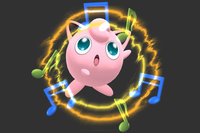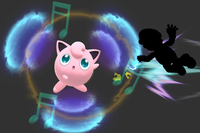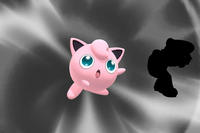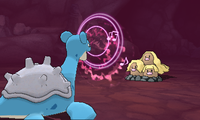Sing
| Sing | |
|---|---|
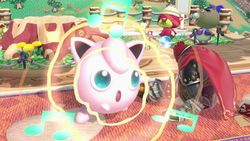 Using Sing in Ultimate. | |
| User | Jigglypuff |
| Universe | Pokémon |
| Article on Bulbapedia | Sing (move) |
| “ | Jigglypuff can put its enemies to sleep if they are in range of its Sing attack, although the attack does not work on airborne foes. | ” |
| —Jigglypuff's trophy description in Melee | ||
| “ | A soothing song that causes drowsiness in nearby opponents. | ” |
| —Super Smash Bros. for Wii U's Quick Guide | ||
Sing (うたう, Sing) is Jigglypuff's up special move in the Super Smash Bros. series.
Overview
Soundwaves and music notes come out from its body and travel out a certain distance. All opponents within range and touching the ground will fall asleep for a short amount of time. This attack does no damage to playable characters and simply disables opponents to set up for attacks. (However, as enemies and bosses cannot be put to sleep, this move deals damage to them instead.) Similar to a grab, opponents can escape the sleep state more quickly by button mashing or rapidly moving the control stick or d-pad (except in the original Super Smash Bros).
In Melee, Brawl and SSB4, the more damage the opponent has, the longer they will remain asleep. However, in Super Smash Bros., the opponent remains asleep for a longer time if they bear a low damage. The time the opponent remains asleep is shortest when bearing any damage over 300%. Additionally, in SSB4 a sweetspot was added closer to Jigglypuff which puts opponents to sleep for longer than usual, with the third soundwave only featuring said sweetspot, and no sourspot. The sourspot's sleep duration is the same as the entire hitbox's sleep duration in Brawl.
Unlike other up special moves, this is not a third jump since it gains no height. Instead, players often use Rollout or an air dodge as an extra jump, or simply use Pound for horizontal recovery. However, it does increase the size of Jigglypuff's ledge-grab box.
Timing of this move is crucial, as the duration of the sleep is short, so that opponents who fall asleep at the beginning may wake up before Jigglypuff finishes singing if they are at low damage. This will leave Jigglypuff very vulnerable to counter-attacks. Using the move in midair can shift this risk somewhat, by ensuring that opponents who fall asleep will do so closer to the middle of the move than at the beginning (so that they will not wake up before the move is over); however, this does not change the fact that the move has no effect on midair foes, and so Jigglypuff will still be vulnerable, only at the beginning of the move rather than at the end.
From Melee onward, Sing can be ledge-canceled, which greatly improves the utility of the move. If Sing is used when Jigglypuff is in midair over a ledge and an opponent is nearby, then the opponent will fall asleep at the beginning of the move, but then Jigglypuff will grab the ledge and the rest of the move will be canceled while the opponent is still asleep for the usual duration. This can be used to set up combos, and can even stall indefinitley with correct timing.
The move is very rarely used in competitive play for singles, due to the move possessing three major flaws. Firstly, the move has very long startup lag with a huge visual cue (since the first soundwave appears before the hitbox comes out), and due to the move dealing no damage to shields and having long ending lag, the move can very easily be shielded and punished. Secondly, the move's range is very limited, especially considering that the move only affects grounded opponents, and as such, against a good opponent, the only realistic way to land the move is to catch an opponent during the ending lag of a powerful attack, however the move's long startup means that it is often more effective to punish the ending lag with Rest instead, which throughout the games has, at most, 1 frame of startup. Finally, although the move usually puts the opponent to sleep for slightly longer than the move's duration at mid to high percents, the opponent can easily mash to wake up before Jigglypuff can act again, making the move nearly useless in singles. However, Sing can be used in team battles very effectively by having Jigglypuff put enemies to sleep, then having its teammate use a fully charged smash attack or powerful special attack like Falcon Punch on the sleeping opponents.
Customization
Special Move customization was added in Super Smash Bros. 4. These are the variations:
| 1. Sing | 2. Hyper Voice | 3. Spinphony |
|---|---|---|
| "A soothing song that causes extreme drowsiness in nearby opponents." | "A funky tune that sends opponents reeling backward if they get too close." | "A thrilling melody that somehow spins enemies around where they stand." |
- Sing: Default.
- Hyper Voice: An offensive variant, this move has a frame speed multiplier of 1.2 (which means it takes 1.2 times (20%) longer to perform the move than the default). Jigglypuff sings and sends three sound waves in intervals. The first sound wave inflicts 3% damage and causes the opponent to flinch. A small amount of time passes before the second sound wave occurs, dealing the same amount of damage. The third sound wave comes a moment after, and deals 5% damage, and causes considerable knockback. Jigglypuff is still vulnerable during this attack, as it is with its standard variation, but it can affect airborne fighters.
- Spinphony: Startup is extremely slow, and the move is executed very slowly as well, due to having a frame speed multiplier of 2. Three slow sound waves emit at long intervals, and each flips the opponent, similar to Mario's Cape. The first sound wave doesn't damage opponents. The second sound wave inflicts 1% damage, and the third inflicts 2% damage. Jigglypuff is extremely vulnerable while using this move, and its slow execution makes it impractical to use. If used in the air, Jigglypuff will lock into the move, and can't be cancelled. Since it takes so long to execute, Jigglypuff can self-destruct by falling into the blast line, even from the top of the stage. Arguably one of the worst custom moves, with its only practical usage being for gimping someone's recovery. However, it cannot do this very effectively, as it causes flinching, granting opponents the ability to reuse any of their recovery moves.
Origin
Sing is based off a move of the same name in the Pokémon games. Introduced in Generation I, Sing is a Normal-type status move that has the sole effect of putting the opponent to sleep. For some Pokémon like Jigglypuff and Blissey, this is the only move they can learn that puts the opponent to sleep, but Sing's very poor accuracy rate of 55% makes it unreliable.
In every Pokémon generation, Jigglypuff's evolutionary family are well known for using this move. A particular Jigglypuff in the Pokémon anime is a recurring character of the early seasons who wishes to be applauded for its music but inadvertently puts people to sleep instead.
Hyper Voice, included in Super Smash Bros. 4 as one of Sing's custom variants, is a Normal-type attack introduced in Generation III that can hit multiple opponents. Jigglypuff can also learn this move by leveling up.
Gallery
Using this move on Pikachu and Charizard in Super Smash Bros. for Wii U.
Sing in Super Smash Bros. for Wii U.
Trivia
- Although it does no damage, Sing can destroy targets in Super Smash Bros. Melee's Target Test, and can also destroy capsules in any mode. It can also be countered from Super Smash Bros. Brawl onward.
- In Event 39: Jigglypuff Live!, there is an easter egg involving the Sing attack. If the Jigglypuff player uses Sing while the jumbotron television in the background is zoomed in on it, then the other Jigglypuff will fall asleep even if they are far away from the player, and the time they sleep will be considerably longer.
- When used against enemies and bosses, the third set of music waves are more damaging than the first two.
- In Smash Run, Sing will cause enemies to tumble as if hit by a strong enough attack. While this is rather obsolete against common enemies, it is quite useful against very tough ones who can be knocked down, such as Reapers, Polar Bears, and unarmored Darknuts.
- Although ineffective, Sing will be used by a CPU-controlled Jigglypuff in Melee during recovery after having used all of its midair jumps, just like any other CPU character would do with its up special (excluding Luigi). This is an example of flawed AI.
- In Smash 64, if Pikachu uses Quick Attack horizontally towards a singing Jigglypuff, Pikachu will slide a great distance as it falls asleep. A similar thing happens when Captain Falcon uses Falcon Kick in Brawl, with Jigglypuff not being damaged at all, though Falcon will slide a shorter distance. In Smash 4, the same will also happen with Charizard and Flare Blitz.
- In Melee, due to the magnifying glass showing characters at a lower resolution and ignoring effects like eye blinks, Jigglypuff's eyes will be open if it uses Sing in one.
- Jigglypuff's eyes are also open when looking at the reflection in Fountain of Dreams, which similarly shows characters at a lower resolution.
- Sing, as well as its customizations, is notably the only up special move that does not aid in recovering offstage, either from a tether or any sort of momentum boost. This technically makes Jigglypuff the only fighter who lacks an up special recovery move (though Yoshi also lacked one in Super Smash Bros. and Melee, but gained one in Brawl).
- Oddly, Sing can be countered despite dealing no damage.

